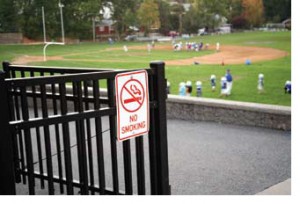L.A.’s great smoking divide
June 22, 2010
 Folks in San Marino, Malibu and Calabasas can breathe easy.
Folks in San Marino, Malibu and Calabasas can breathe easy.
But for those of you in Quartz Hill, Lancaster and West Hollywood—don’t throw away the nicotine patches just yet.
A new public health report on smoking in L.A. County is out, and it’s naming names. The report is the first of its kind to break out the county’s adult smoking rates by city and community. The disparities are striking.
San Marino boasts the county’s lowest rate of adult smoking, 5.3%, closely followed by Malibu at 5.8%. Next are La Canada-Flintridge (6.4%) and Calabasas (7.3%.)
“Our people in the community care about health. We care about and talk about healthy lifestyles,” says San Marino Mayor Dennis Kneier. His constituents, he says, “are very educated people who are aware of and conscious of the health risks of smoking.”
At the other end of the spectrum is Quartz Hill in northeast Los Angeles County, where 21.9% of the adult population smokes. Lancaster is next, at 21.7%.
“Coming from a long line of smokers, let me tell you: people up here smoke too much,” says Cindy Brody, a library assistant in Quartz Hill. “I was born here, and it hasn’t changed much in over 50 years. Face it, we’re not Hollywood.”
In West Hollywood, which has the fourth highest incidence of adult smoking in the county (19.6%), a task force of business and community leaders was convened in December to explore a new ordinance that would ban outdoor smoking on restaurant patios, open common areas and service areas such as ATM lines. The measure is expected to be brought before the city council in the next few months. The city already prohibits indoor smoking in public places and workplaces.
The county report draws on 2007 smoking data and population information from the 2000 U.S. Census. Some cities and communities, such as Avalon, Bradbury and Hidden Hills, were too small to be included. In all of Los Angeles County, there are an estimated 1.06 million smokers—14.3% of the adult population. (To see how your community ranks, scroll down to Table 1 of the report.)
Dr. Jonathan E. Fielding, the county’s director of public health, says in a foreword to the report that Los Angeles has one of the lowest smoking rates of any big metropolitan area in the U.S. He credits that to factors such as cigarette tax policy, “aggressive anti-smoking media campaigns” and smoke-free indoor ordinances.
He also reports that smoking among high school-age teens in Los Angeles County has declined dramatically, from 26% in 1997 to 12% in 2005. But smoking rates among adult smokers have remained steady since 2002. In addition to the heavy toll this takes on individuals and families, smoking also contributes to the $4.3 billion that tobacco-related diseases cost the county each year—$2.3 billion of it spent directly on health care.
Fielding said in a statement released with the report that the information is meant to help local leaders develop effective anti-smoking policies. “Understanding where smoking rates are highest in the county allows policy makers to develop support for and establish programs and policies in the fight against tobacco use,” Fielding said. However, the report does not attempt to correlate such policies with smoking rates in individual communities.
L.A. County‘s smoking disparities aren’t just geographic. The report says men smoke more than women, and African Americans light up more than other ethnic and racial groups. People with college degrees and higher incomes tend to smoke less than others.
In Quartz Hill, Brody, 55, thinks her community’s smoking habit can be partly attributed to economics.
“It’s a poor community, nobody has any money and they have nothing to do up here,” she says. She notes that long commuting distances also contribute to high stress levels for many.
Never a heavy smoker, Brody gave up cigarettes some 30 years ago.
“Now if I could get my husband to quit,” she says, “I’d be happy.”
This is the first L.A. County Public Health report to break out smoking rates by city and community. Previously, the department created such reports on childhood obesity and premature deaths from heart attacks and strokes.
Posted 6/22/10












 405 bridge work causes a stink
405 bridge work causes a stink
